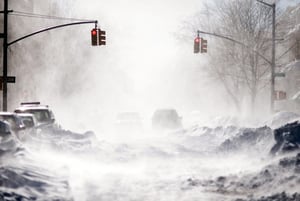When news outlets assign silly names to serious winter storms—Snowpocalypse. Snowmaggeddon. Snowzilla, and the like—it diminishes the true dangers of weather-related events like this January’s storm Jonas.
It’s easy to do. Unlike some of Mother Nature’s other natural disasters, snowstorms arrive gracefully, accumulate gently and paint their mayhem gradually. They’re perhaps the only weather-related incident to leave momentary beauty in its wake.
The devastation that accompanies that beauty, however, is very real: Jonas killed more than 40 people, caused record coastal flooding, and caused multi-states of emergency.
Fortunately, emergency response personnel and public service officials see right through snow’s beauty and understand its potential for devastation.
With precipitation patterns similar to an extratropical storm, blizzards and nor’easters are often accompanied by flooding, hurricane-force winds, power outages, inclement road conditions, and more.
Despite all of their dangers, snowstorms allow plenty of time for you to prepare your emergency response. However, things don’t always go as planned. Sometimes lessons aren’t learned and holes in emergency procedures aren’t found until after the storm is long gone – and it’s too late.
The best time to prepare for the next storm is immediately after the most recent one ends. Reflecting back on how well your people, process, and technology worked post-incident is the best thing to do to be ready for the next one. It’s only then that you can evaluate what worked, and what can be improved.
To make things easier for you, we’ve created this checklist of things that you can do now to make sure that you’re ready for the next winter-weather emergency:
1. Double-check your checklist
Does everyone know how to log in to the notification system? Seems simple, right, but the devil is in these details. Oftentimes when users set up their emergency notification procedure and system, they set them…and then forget them. When a storm is ‘a brewing’ it’s imperative for you and your emergency response team to go over your processes.
Double check your checklist:
1.) Does everyone know how to log in from their workstation and personal devices?
2.) If they know how, are they able to log in?
3.) Don’t forget to check your passwords.
4.) Send a test message.
Here’s an easy tip: Have each Administrator bookmark their own secure log-in link. If issues still arise, contact your super administrator or primary contact within the IT department. Provided proper credentials are given, Omnilert is always available to assist customers with log-ins.
2. Name a coach, and a backup
Just like every sports team needs a coach to take the lead, so does your emergency response management team. Who is the leader that will determine the closure and ultimately push the send button on the mass communication?
Once the coach is clear, then it’s time to appoint the secondary staff. There should be no question as to who is next in the line of responsibility. You don’t want to find yourself unable to execute an emergency response alert because a single member of the team is unavailable.
3. Review policies and procedures
We’ve already determined that opinions differ on whether or not a weather storm is an emergency. That’s why it’s so important to ensure that you and your team are all on the same page when it comes to your emergency response policies and procedures. Everyone needs to be operating on the same definition of what constitutes an emergency or warrants a closure. Will you be following the local school system’s closures or following the lead of the federal government or FEMA? In an emergency there is no room for gray areas.
Map out a precise outline of who will receive your messages, and identify the appropriate channels to reach them.
Not all weather-events should be weighted the same, so identify ahead of time those events when it is appropriate to send a text versus a call, email, desktop alert, etc. Perhaps a combination of the options is needed. The methods and times that recipient get messages should be specifically selected based on the situation.
4. Sanity check your templates
You trust your team, but when was the last time you reviewed the actual words in your emergency response message templates? Wording is very important—it represents the professionalism of your organization, and a lot could be at stake if any mistakes are made.
If you’re aware that winter-weather system is looming, run your templates by the those who have a vested interest in them being clear and concise. This is especially important if the message is crafted by an employee in a department that is not well-versed in writing external messaging. Do yourself a favor and have your communications or public relations department check your message templates.
5. Verify the data on your dashboard
Take a look at the cleanliness of your emergency contact data. Review the entire system and have a close look to make sure the number of subscribers on the dashboard looks correct. Check in on the renewals, updated contacts, and opt-ins. You may need to go back and update all of their contact information or settings. A message sent, but never received, is of no good to anyone.
By reviewing your response to Jonas while it’s fresh, you’ll be armed and ready for the next inevitable storm. Making sure that you’re ready to keep everyone informed will minimize the potential devastation of the next severe winter weather event.


